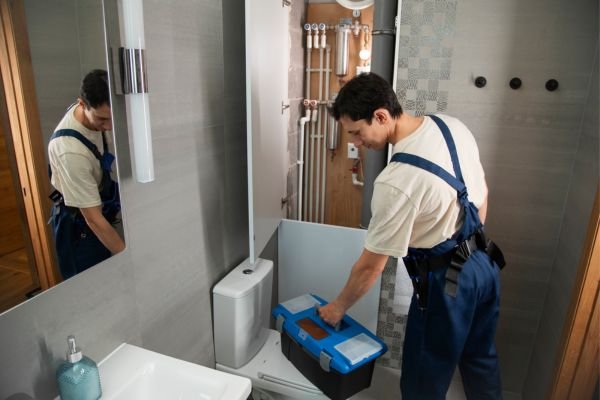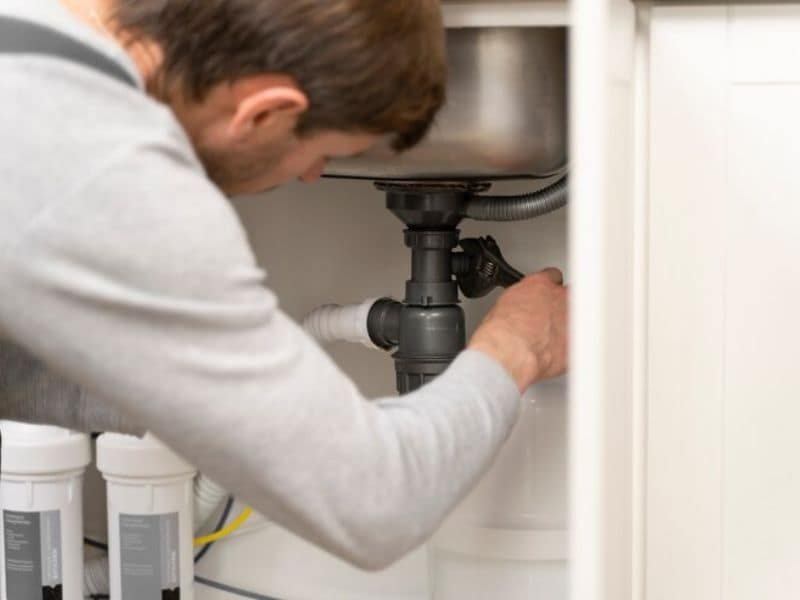Getting a new toilet installed may seem like a minor home update—but the cost can vary more than you think. Whether you’re replacing an old toilet or upgrading to a high-tech model, understanding what plumbers charge and why can help you budget smarter and avoid surprise fees.
Let’s break down what you can expect to pay, what factors influence the cost, and when it’s worth hiring a pro versus going DIY.
Average Cost to Install a Toilet
Toilet installation prices are usually directly straight, but they can move down on your location and project nuances.

National Average and Cost Range
On average, a professional plumber spends an average toilet installation of $ 125 to $ 350. But in costly areas or for complex work, you may have to pay up to $ 500 or more.
Here’s a basic pricing overview:
| Service | Estimated Cost |
| Basic replacement (labor only) | $125–$250 |
| New installation (with plumbing) | $250–$500+ |
| High-end or smart toilet install | $300–$600+ |
If you’re also buying a new toilet, factor in an additional $100–$500+ depending on the model.
Labor vs. Material Costs Explained
Plumbing labor typically accounts for 60–80% of the total cost. Material costs—like new wax rings, bolts, hoses, or a shutoff valve—are usually minimal (around $20–$40).
In other words, you’re paying for expertise, speed, and assurance that it’s done right the first time.
READ MORE: How Long Does a Water Heater Take to Heat Up?
Factors That Affect Toilet Installation Cost
Not all toilet installs are created equal. Several factors can drive the price up or down.
Type of Toilet Being Installed
The complexity of the installation depends largely on the type of toilet:
- Standard two-piece toilet: Easiest and cheapest to install
- One-piece toilet: Heavier, harder to maneuver
- Wall-mounted toilet: Requires wall bracing and in-wall plumbing—significantly more labor-intensive
- Smart toilet or bidet: May need electrical wiring and additional fittings
The fancier the model, the more time and tools are required—which raises labor costs.
New Installation vs. Replacement
If you’re replacing an old toilet, it’s usually a quicker job. But if you’re installing a toilet where one didn’t exist before, the plumber must:
- Run new plumbing lines
- Possibly adjust the subfloor
- Ensure proper drainage and venting
This can double or triple the installation cost.
Location and Accessibility
- A ground-floor bathroom with easy access will cost less.
- A third-floor or tight bathroom layout means more labor and higher fees.
If the plumber has to remove and reinstall flooring or repair drywall, those costs add up fast.
Cost of Toilet Installation by Type
Let’s dig into pricing based on different toilet styles.
Standard Two-Piece Toilets
- Installation Cost: $125–$250
- Toilet Price: $100–$300
These are the most common and economical options. Installation is typically fast and straightforward.
One-Piece Toilets
- Installation Cost: $200–$350
- Toilet Price: $200–$600+
One-piece toilets are easier to clean but heavier to install, requiring two people or lifting tools.
Wall-Mounted Toilets
- Installation Cost: $400–$1,000+
- Toilet Price: $300–$800+
These require hidden tanks and structural support. Ideal for minimalist designs, but costly to install or repair.
Smart or Bidet Toilets
- Installation Cost: $300–$600+
- Toilet Price: $400–$2,000+
Advanced models may include hot seats, air dryers and biddet functions. These usually require electrical wires and careful fittings.
READ MORE: Can a Water Heater Explode If Turned Off?
Itemized Breakdown of Toilet Installation
Understanding the line-by-line cost helps you spot unnecessary charges and better compare quotes between plumbers.
Typical Labor Charges
Plumbers typically charge by the job rather than by the hour for toilet installations. However, if they do bill hourly, expect rates between $50–$150 per hour, depending on your location.
What’s included in standard labor:
- Removing the old toilet
- Cleaning the flange area
- Installing new wax ring and bolts
- Positioning and sealing the new toilet
- Connecting the water supply
- Testing for leaks
Expect extra labor fees if they have to:
- Reinforce or replace the toilet flange
- Replace the shutoff valve
- Reseal or repair the flooring
Parts and Supplies
Some plumbers include minor parts in their pricing, but others charge separately for:
- Wax ring or rubber seal: $5–$10
- Mounting bolts and caps: $5–$10
- Flexible water supply line: $5–$15
- New shutoff valve (if needed): $10–$25
Total supply costs are usually under $40, but be sure to ask if they’re included in the quote.
Disposal of Old Toilet
Some plumbers charge an additional $ 25- $ 75 to remove your old toilets. Other people include this service for free, especially if you are using them to install the new. If you are settling yourself, remember that the toilet is considered heavy waste in most areas. You may need this:
- Schedule a special curbside pickup
- Drop it off at a waste management facility
READ MORE: How to Install Heating Element in Water Heater
DIY vs. Professional Installation
Tempted to install the toilet yourself? It’s doable, especially if you’re handy—but it’s not always worth the savings.
Pros and Cons of Doing It Yourself
Pros:
- Save $125–$350 in labor costs
- You’ll learn a valuable skill
- Great for straightforward replacements
Cons:
- Messy and physically demanding
- Easy to mess up the wax ring seal
- Risk of leaks or floor damage
- Voids warranty if incorrectly installed
Unless you’re confident in your plumbing skills, hiring a licensed pro is usually the safer bet.
When You Should Hire a Pro
- You’re installing a wall-mounted or smart toilet
- The toilet is on an upper floor or in a tight space
- There’s visible water damage or corrosion
- Your home has older plumbing or unusual configurations
A professional can complete the job in under 2 hours—and give you peace of mind it’s leak-free.
How Long Does It Take to Install a Toilet?
Toilet installation is generally a quick job—assuming there are no surprises behind the base or flooring.
Standard Timeline for Pros
- Basic replacement: 1–2 hours
- Complex installation (e.g., wall-mounted or smart toilets): 3–5 hours
- New toilet + plumbing lines: Full day or more
The plumber will:
- Remove and dispose of the old toilet
- Inspect and prep the flange
- Install the new unit
- Seal, test, and clean up
What Can Delay the Job?
- Rusted bolts that are hard to remove
- A damaged or misaligned flange
- Uneven flooring requiring shimming
- Needing to move the drain or install a new shutoff valve
Delays can add $50–$200 in extra labor if the problem requires significant effort or additional parts.
Signs You Need a New Toilet
Sometimes people replace toilets just for aesthetics—but in many cases, it’s a necessary upgrade.
Constant Repairs and Leaks
If your toilet constantly:
- Leaks around the base
- Runs after flushing
- Needs frequent repairs
…it may be more cost-effective to replace it altogether. The cumulative cost of parts and labor can easily exceed the price of a new unit.
Outdated Models or Water Inefficiency
Older toilets can use up to 6 gallons per flush, while modern high-efficiency toilets use as little as 1.28 gallons. Replacing an old toilet can:
- Save water and lower your utility bill
- Qualify you for local rebates
- Add value to your home with a more modern look
Ways to Save Money on Toilet Installation
Want to upgrade your toilet without breaking the bank? Here are a few tips.
Buying the Toilet Separately
While plumbers may offer toilet models for sale, you’ll often find better deals:
- Online retailers
- Big box hardware stores
- Manufacturer sales or rebates
Just be sure to check compatibility and confirm with your plumber that the model you purchase will work in your space.
Bundled Plumbing Services
If you’re already hiring a plumber for another job (like installing a sink or water heater), ask if they offer a discounted rate for bundling multiple services.
This can reduce labor costs and save you a second service call.
READ MORE: Can You Use a Milk Frother to Heat Water?
Questions to Ask Your Plumber
Renting a plumber may feel like a simple transaction, but asking the correct question makes sure that you will not be surprised by hidden fees or incomplete work.
Before Hiring
When contacting a plumber for a quote, ask:
- Is this a flat-rate or hourly fee?
You want to know if the price will increase if complications arise. - What’s included in the installation?
Some plumbers include minor materials and cleanup, others charge separately. - Do you dispose of the old toilet?
If not, you’ll need to handle this or pay an extra disposal fee. - Are there any potential extra charges I should know about?
Plumbing is full of surprises—get clarity on how they handle unexpected repairs. - Is your work insured and licensed?
Always work with licensed professionals to ensure safety and code compliance.
Warranty and Cleanup Details
A good plumber will stand behind their work. Ask:
- Is your work covered by warranty?
A one-year warranty on labor is fairly standard. - What’s your policy if the toilet leaks after installation?
This helps ensure they’ll come back to fix mistakes. - Do you clean up after installation?
The best pros leave the space as clean as they found it.
Being active with these questions can help in avoiding conflict and despair later.
Conclusion
Toilet installation isn’t just about swapping one bowl for another—it’s a detailed job that involves plumbing knowledge, precision, and proper sealing. While the national average for a plumber to install a toilet ranges from $125 to $350, that cost can climb depending on the type of toilet, the complexity of the job, and any unexpected issues along the way.
If your home is older, your bathroom is difficult to access, or you’re upgrading to a high-end model, don’t be surprised if your final bill pushes $400 or more. But hiring a professional ensures the job is done right—no leaks, no mess, and no wasted time.
Whether you’re planning a simple replacement or a bathroom upgrade, knowing what affects the price (and what questions to ask) helps you stay in control of your budget and your comfort.
FAQs
1. Is toilet installation covered by warranty?
Most plumbers offer one year labor warranty. The toilet usually comes with a manufacturer’s warranty of 1-5 years depending upon the make.
2. Can a handyman install a toilet?
Yes, but be cautious. A licensed plumber is trained to spot and fix issues like flange damage or water line problems. In some areas, plumbing work must be done by a licensed contractor to comply with code.
3. Does the plumber provide the toilet?
Sometimes. Many plumbers can supply a standard toilet, but it may cost more than buying it yourself from a home improvement store. Always clarify this before scheduling.
4. Will I need a permit to install a toilet?
In most cases, no permit is needed for replacing an existing toilet. However, new plumbing installations may require one depending on local building codes.
5. How much does it cost to remove and replace a toilet?
If no additional repairs are needed, expect to pay $150–$300 total for both removal and installation. Extra plumbing work or high-end toilets can push the price higher.

